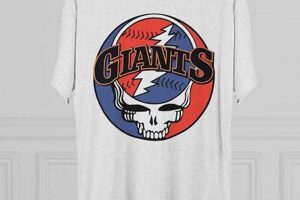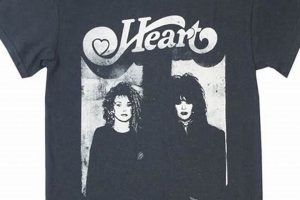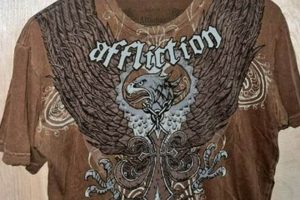These shirts are characterized by their distinctive closures, employing simulated or genuine mother-of-pearl snaps instead of traditional buttons. A common example includes western-style shirts from the mid-20th century, frequently adorned with intricate embroidery or contrasting yokes.
These garments hold cultural significance, reflecting the aesthetics of the American West and country music. They offer a unique blend of style and practicality, finding appeal among collectors and those seeking a touch of retro fashion. Their durability and distinctive appearance contribute to their continued desirability.
The following sections will delve into the details of identifying authentic examples, exploring variations in style and construction, and offering guidance on proper care and maintenance to preserve their value and longevity.
Considerations for Acquiring and Maintaining Authenticity
The following guidelines offer valuable insight when evaluating and preserving such apparel.
Tip 1: Examine the Snap Construction: Authentic examples typically exhibit robust snap mechanisms. Assess the tightness and secureness of each snap closure. Loose or easily detached snaps may indicate damage or replacement.
Tip 2: Scrutinize the Fabric: Period-correct textiles often display a unique texture and weave distinct from modern materials. Investigate the fabric composition to determine if it aligns with the era the shirt is claimed to originate from.
Tip 3: Assess the Stitching Quality: Vintage garments usually feature meticulous stitching. Inspect the seams for evenness, tight stitching, and minimal fraying. Irregularities can point to reproduction or poorly executed repairs.
Tip 4: Verify the Label Details: Examine the label’s font, design, and material. Research the brand associated with the label and compare it to known historical information to confirm its authenticity.
Tip 5: Identify Unique Western Styling: Recognize hallmark Western style indicators on the apparel. These can include sawtooth pockets, smile pockets, or shotgun cuffs. The incorporation and design of these details are key indicators.
Tip 6: Inspect Yoke Design: Note the design and embellishment on the front and back yokes. Intricate embroidery or unique patterns are characteristic features, and their condition is important.
Tip 7: Account for Natural Wear and Tear: Genuine vintage items inevitably exhibit some level of wear. Slight fading, minor imperfections, or subtle fabric wear are acceptable, but excessive damage can devalue the shirt.
Adhering to these recommendations will greatly assist in identifying genuine artifacts, ensuring a worthwhile addition to any collection.
The subsequent section will discuss cleaning and preservation techniques to safeguard these valuable articles of clothing.
1. Construction
The construction of vintage pearl snap shirts is a critical determinant of their value, authenticity, and durability. Examining the methods and materials employed in their creation provides insights into the era of manufacture and the quality of craftsmanship.
- Seam Types and Stitching Density
The type of seams used, such as flat-felled or chain-stitched seams, affects the garment’s strength and resilience. Higher stitching density generally indicates superior quality and greater resistance to wear and tear, offering better protection for vintage pearl snap shirts.
- Yoke Construction
The yoke, a shaped piece of fabric across the shoulders, often features intricate designs and multiple layers of fabric for reinforcement. The complexity and precision of the yoke construction contribute significantly to the shirt’s overall structure and aesthetic appeal.
- Pocket Attachment Methods
Pockets on these shirts can be attached using various methods, including single-needle stitching or bar-tacking. The security and neatness of the pocket attachment are indicators of the garment’s quality and the care taken during its production.
- Collar and Cuff Reinforcement
Collars and cuffs, areas prone to wear, are often reinforced with interfacing or additional layers of fabric. The presence and condition of this reinforcement are essential for assessing the shirt’s structural integrity and longevity.
These facets of construction collectively reveal the craftsmanship inherent in vintage pearl snap shirts. Understanding these elements aids in evaluating the garment’s condition, authenticity, and overall value, enabling informed decisions regarding acquisition and preservation.
2. Fabric
The fabric comprising a pearl snap shirt significantly dictates its durability, aesthetic appeal, and historical context. The choice of material directly influences the garment’s suitability for various climates and activities, contributing to its longevity. For example, shirts constructed from heavier twill fabrics, common in workwear applications, demonstrate enhanced resistance to abrasion and tearing compared to those made from lighter cotton broadcloth, intended for more formal or leisure purposes. Material selection consequently affects the garment’s overall perceived value and collectibility.
Examining the fabric composition provides critical clues about the shirt’s era and intended use. Gabardine, a tightly woven worsted wool or cotton fabric, was frequently used in higher-end examples from the mid-20th century, reflecting the period’s emphasis on tailored silhouettes and durable materials. Conversely, the emergence of synthetic blends, such as polyester-cotton mixes, in later decades marks a shift towards easier care and increased affordability, altering the fabric’s drape and texture. Recognizing these variations is crucial for discerning genuine vintage pieces from modern reproductions. The sourcing of specific fabrics (e.g., Cone Mills denim) can also add provenance to certain garments, linking them to specific manufacturers and periods.
In summary, the fabric is not merely a component but a foundational element that determines the essence of a pearl snap shirt. Understanding the relationship between fabric type, construction techniques, and historical context allows for a more informed assessment of a shirt’s value and authenticity. The composition significantly impacts the care requirements and overall preservation strategy, ensuring these garments endure for future generations. Ignoring the intricacies of the fabric essentially overlooks a crucial aspect of the pearl snap shirt’s identity and history.
3. Hardware
The hardware, specifically the pearl snaps, constitutes a defining characteristic of the garment, influencing both its aesthetic appeal and functional integrity. These closures, typically composed of a cap featuring a simulated or genuine pearl insert, a socket, and a post, directly impact the shirt’s visual identity and ease of use. The quality and material composition of the snaps correlate to the overall durability and perceived value of the shirt. For instance, shirts featuring snaps with intact pearl inlays and secure attachments command higher prices in the vintage market, as they demonstrate superior craftsmanship and preservation. Failure of these snaps, due to corrosion or physical damage, diminishes the garment’s functionality and market value. The choice of snap material (plastic, metal, or a combination thereof) can also offer clues about the shirt’s manufacturing era and intended market segment. Therefore, detailed examination of the hardware provides critical information for evaluating a shirt’s authenticity and condition.
Beyond aesthetics, the snap mechanism’s functionality is paramount. Properly functioning snaps ensure secure closure, preventing unwanted openings during wear. Conversely, corroded or weakened snaps can result in unreliable closure, rendering the shirt impractical. Replacement snaps, while sometimes necessary to restore functionality, can detract from the garment’s originality and, consequently, its value. When assessing a potential purchase, careful inspection of each snap, including its attachment method and closure strength, is essential. Vintage examples featuring original, well-maintained hardware are prized for their historical accuracy and enduring functionality. The presence of branded snaps, bearing the manufacturer’s logo, further enhances the shirt’s provenance and collectibility. The absence of such branding or the use of generic replacements suggests potential alterations or repairs, impacting the garment’s historical integrity.
In conclusion, the hardware is not merely an ancillary component but an integral element defining the pearl snap shirt’s character and value. Its condition and originality directly affect the shirt’s aesthetic appeal, functionality, and historical authenticity. Careful evaluation of the snaps is, therefore, a critical step in assessing the overall quality and desirability of these vintage garments, underscoring the interconnectedness of hardware and overall assessment. Understanding the variations in snap design, materials, and manufacturing techniques allows for a more nuanced appreciation of the pearl snap shirt’s rich history and enduring appeal.
4. Embroidery
Embroidery on vintage pearl snap shirts is a defining characteristic, often indicating the garment’s origin, era, and intended market. The presence and quality of the embroidery are pivotal factors in determining a shirt’s desirability and value to collectors. Intricate designs, ranging from floral patterns and Western motifs to geometric shapes and abstract art, exemplify the shirt’s unique identity. Consider, for example, the classic “smile” pockets, frequently adorned with chain-stitched embroidery, a hallmark of many mid-century Western shirts. Such embellishments served not only as decorative elements but also as a form of branding, allowing manufacturers to distinguish their products and appeal to specific consumer tastes. The craftsmanship exhibited in the embroidery reflects the manufacturing standards of the time, with higher-end shirts often featuring more elaborate and detailed designs. The condition of the embroidery, therefore, offers insights into the shirt’s overall care and preservation. Faded threads, loose stitches, or missing elements can detract from its value, while well-maintained examples command premium prices.
The techniques employed in the embroidery varied based on the period and manufacturer. Chain-stitch embroidery, created using a specialized machine, was commonly used for outlining designs and adding texture. Satin stitch, characterized by closely spaced parallel stitches, was often utilized to fill in larger areas and create smooth, glossy surfaces. Appliqu, involving the attachment of fabric pieces to the shirt’s surface, added depth and dimension. The choice of thread colors and materials also played a crucial role in the overall aesthetic. Vibrant hues, such as turquoise, red, and gold, were popular in Western-themed embroidery, reflecting the region’s bold and expressive style. In contrast, more subdued tones were often used on shirts intended for more formal occasions. Identifying the specific embroidery techniques and materials helps to ascertain the shirt’s authenticity and provenance. The presence of unique or unusual embroidery designs can also increase a shirt’s collectibility, particularly if they are associated with specific brands or historical events. Documented cases of shirts worn by prominent figures within the country music scene or featured in classic Western films highlight the influence and cultural significance of embroidered pearl snap shirts.
In summary, embroidery is an indispensable element in understanding the value and history of vintage pearl snap shirts. Its presence, quality, design, and execution provide essential clues about the shirt’s origins, intended use, and overall condition. Recognizing the nuances of embroidery techniques and materials enables a more informed assessment of the shirt’s authenticity and collectibility, and the ability to appreciate these aspects ensures continued appeal within the vintage market. The appreciation of these garments as cultural artifacts requires that these factors be considered when evaluating their authenticity, quality, and cultural significance.
5. Labeling
Labels within vintage pearl snap shirts serve as vital indicators of authenticity, origin, and manufacturing period. Their presence and condition offer crucial insights for collectors and historians seeking to understand the garment’s provenance and value.
- Brand Identification
The primary function of a label is to identify the manufacturer. Brands such as H Bar C, Rockmount Ranch Wear, and Panhandle Slim were prominent producers of pearl snap shirts, and their labels are frequently encountered in the vintage market. The specific font, design, and materials used in these labels varied over time, providing clues to the shirt’s age and origin.
- Fabric Composition
Many vintage labels include information about the fabric composition, such as “100% Cotton” or “Durable Press.” This information is useful for determining the garment’s care requirements and assessing its quality. The absence of such information, or the use of vague terms like “Rayon,” may indicate a lower-quality garment or a reproduction.
- Size and Care Instructions
Labels often include the shirt’s size and care instructions, such as “Machine Wash Cold” or “Dry Clean Only.” These details can be helpful for determining whether the shirt will fit and how to properly maintain it. The language used in the care instructions can also provide clues to the shirt’s age; for example, older labels may use terms that are no longer common.
- Union Label
Some vintage pearl snap shirts feature a union label, indicating that the garment was manufactured by unionized workers. The presence of a union label can be a sign of higher quality and ethical labor practices. The specific design of the union label can also help to date the shirt, as different unions used different logos and slogans over time.
The information contained within these labels provides valuable context for understanding a vintage pearl snap shirt’s history and provenance. Their careful examination is essential for accurately assessing the garment’s authenticity and value, contributing to a more informed appreciation of these iconic pieces of Western wear.
6. Era
The era of manufacture profoundly impacts the style, materials, and construction techniques employed in vintage pearl snap shirts. The mid-20th century witnessed a surge in popularity of these garments, coinciding with the rise of Western films and country music, thereby influencing design aesthetics. Shirts produced in the 1950s, for example, often exhibit bolder color palettes and more elaborate embroidery compared to those from the 1970s, reflecting shifting fashion trends and material availability. Identifying the specific era allows for a more accurate assessment of a shirt’s authenticity and cultural significance, providing context to its value. For example, shirts from the Nudie Cohn era are highly sought after. These shirts were known for their flamboyant style.
Understanding the era also enables a more informed evaluation of the materials used. Pre-1960s shirts frequently feature natural fibers such as cotton and wool, while later examples may incorporate synthetic blends like polyester to increase durability and reduce costs. Recognizing these material distinctions assists in determining the shirt’s age and intended market. A shirt advertised as “vintage” but constructed from predominantly synthetic fibers may warrant closer scrutiny. Moreover, variations in collar styles, pocket designs, and snap types can be traced to specific periods, offering further clues about the garment’s origins. Shirts from the 1940s typically feature smaller collars and plainer snap designs. Whereas 1960s-1970s are characterized with larger collars.
In essence, the era is an indispensable component in the authentication and appreciation of vintage pearl snap shirts. It shapes the garment’s aesthetic qualities, influences the materials and construction techniques employed, and imbues it with cultural significance. Comprehending the connection between era and shirt characteristics equips collectors and enthusiasts with the knowledge necessary to make informed decisions, ensuring the preservation of these artifacts of Western heritage.
Frequently Asked Questions About Vintage Pearl Snap Shirts
The following addresses common inquiries regarding the identification, care, and valuation of these garments.
Question 1: What are the primary distinguishing characteristics of a vintage pearl snap shirt?
The presence of pearl snaps instead of buttons, distinct Western-style yokes, specific fabric types (e.g., chambray, gabardine), and unique embroidery patterns are key indicators. The age and brand of the shirt are also factors.
Question 2: How can one determine the approximate age of a pearl snap shirt?
Examining the label (font, logo, and union labels), fabric composition (natural vs. synthetic fibers), and style elements (collar size, pocket design) can provide clues. Resources detailing brand histories and fashion trends can assist in dating the shirt.
Question 3: What are the most common issues affecting the value of a vintage pearl snap shirt?
Damage to the pearl snaps, significant staining or tearing of the fabric, alterations to the original design, and missing labels can substantially reduce value. The rarity of the brand and design also influence pricing.
Question 4: What are the recommended methods for cleaning and preserving these garments?
Gentle hand-washing or professional dry cleaning is advised. Avoid harsh detergents and high heat. Store shirts flat or on padded hangers in a cool, dry place away from direct sunlight.
Question 5: Are reproduction pearl snap shirts prevalent in the market?
Yes, reproductions exist. Examine stitching quality, fabric texture, and snap construction closely. Research reputable vintage dealers and consult online resources to identify potential discrepancies.
Question 6: What resources are available for further research on vintage pearl snap shirts?
Online forums, vintage clothing guides, and specialized books on Western wear provide valuable information. Contacting historical societies and museums with textile collections may also offer insights.
Proper authentication and preservation are critical to retaining value.
This now concludes the FAQ section. Additional resources are in the following sections.
In Conclusion
The examination of the vintage pearl snap shirt reveals a multifaceted garment steeped in history, cultural significance, and aesthetic appeal. From its distinctive hardware and intricate embroidery to its era-specific construction and labeling, each element contributes to its overall value and authenticity. Understanding these nuances is essential for collectors, enthusiasts, and historians alike.
Continued diligence in preservation and research will ensure that the legacy of the vintage pearl snap shirt endures, offering future generations a tangible connection to the past and a compelling example of enduring design and craftsmanship. The ongoing appreciation and study of these garments will help to preserve a significant element of cultural heritage.







